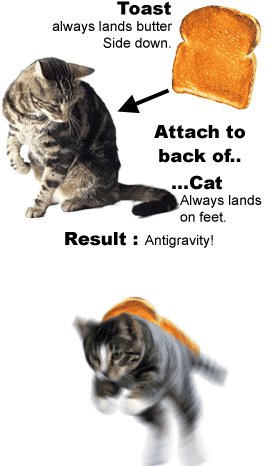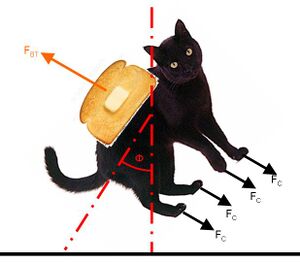The second law of quantum physics
The second law of quantum physics is a neoteric law that states that "a cat with a slice of buttered toast strapped to its back (where the buttered side is up), if dropped, will produce anti-gravity." Established after the 2006 the buttered toast and cat experiment trials, the second law of quantum physics is the most recent fundamental in the study of quantum physics.
Experiment[edit]
The Madhatter Project was the first scientific exploration into the theory of perpetual motion and anti-gravity involving buttered toast and cats. Several theories and controls were established based on Murphy's law application for antigravitatory cats.
But when a piece of buttered toast, which is known to land on its buttered side 100% of the time (due to the buttered side's weight ratio) was glued to the back of a Russian blue cat (cats, according to the Cats conservation law, always land on their feet) and tossed from a crane in a 2006 experiment, the results were surprising. The cat and buttered toast fell normally and reached terminal velocity due to the force of gravity until inches before reaching the ground, then the adhesived mass of the cat and toast levitated and spun to no end. The results observed were similar to those of magnetic levitation, in which opposite poles repel to the point of suspension in the air.
The same experiment was repeated numerous times, and with the exception of one instance (where the toast was glued backwards and the cat landed on the ground on its feet; cat guts flew everywhere, and both the toast and cat died), all had the same results.
Thus led to the adoption of the second law of quantum physics. More recent studies done on dogs and toast with margarine are inconclusive.
Principles of motion[edit]
To determine the motion of a cat with a slice of buttered toast strapped to its back, let FC be the attractive forces of each of the cat's feet to the carpeting, and let FBT be the net rotational torque imposed by the carpeting upon the buttered side of the toast.
By the 42nd proposition of Murphy's laws, the system will begin to rotate in a counterclockwise fashion, causing the cat (C) to experience a large measure of confusion. The partially melted butter (B), which is adhered to the toast (T) by comparatively weak Van der Waals forces, is overwhelmed by the large centrifugal fictional force, though the buttered toast (BT) and cat (C) will in fact cancel out each other's forces to fall on their butter side/feet, causing the buttered toast/cat (BT+C) to spin in a clockwise motion. The spinning cat and toast (C+T), having thus divested itself of surplus butter, will then experience tidal drag within the Earth's gravitational field until such time as rotational equilibrium is restored.
There have been many arguments amongst mathematicians over how to represent this using confusing numbers and symbols rather than confusing big words. Some argue that there are no measurements yet on the exact forces exerted by toast and a cat's feet (which more of a pull towards the ground), and so a mathematical variable must be given. Others don't view the equation as being so versatile, as it is assumed that any future measurements will prove to be universal. That is, all toast and all cats, regardless of size, will exert the same force (somewhat similar to how all objects undergo the same acceleration due to gravity). Regardless, it is very much true that both the cat's feet and the toast must exert the exact same amount of force, otherwise one would prove dominant.
It is accepted by many that, mathematically, where FBT is the force exerted by the butter so that it falls down, and FC are the forces the cat's feet exert so that it doesn't break its ass when falling, the following equation is true:
Such that Θ = π + 3μ√2 gives us that when:
In simpler terms:
Thus, the cat defies gravity.
Perpetual motion?[edit]
There have been debates as to whether or not this phenomenon can be considered a type of perpetual motion. Realistically, no. Toast and a cat are both organic, and as such, must begin to decay at one point. Cats die and toast goes stale, so eventually the motion will end. This is also given that no external factors influence the motion, which is unlikely.
The life of the cat could theoretically be extended by enclosing the landing site in a box containing a source of radiation, and closing said box once the cat is safely inside — thanks to the law of quantum possibilities, the cat is simultaneously both dead and alive. If the box is never opened, the quantum state of the cat being alive continues to cause the cat and toast to spin.
The deterioration of the toast from molds could also be prevented through the use of a desiccant to keep the toast, cat, and environment dry and prevent mold from forming, as mold requires moisture. This, however, seems impossible, as cats produce moisture, as does butter, both of which are a requirement for the experiment. Applying a desiccant to either could have negative consequences, such as de-buttering the toast or de-living the cat.
Proposed inverse theory[edit]
- Main article: Proposed inverse of device
Some have suggested that an inverse of the experiment would be possible. The inverse would consist of a piece of buttered toast placed butter-side-up to the stomach of a cat. Hypotheses have suggested that the cat would attempt to land on its legs, but the non-buttered side of the toast would prevent it. Likewise, the buttered side of the toast would want to land, but the cat's back would be unable to hit the ground.
However, while this would seemingly have the same effect as the normal experiment, it might actually have a quite different effect where the cat and toast would be crushed into singularity, altering matter itself in the process, and thus possibly producing radiation or even creating a black hole. This would occur because unlike the traditional device where the cat and toast repel opposite each other, the inverse device has the cat and toast repel towards each other. This squeezes the cat and toast into an infinitely small and dense piece of matter, much like a black hole. The cat, however, would escape due to its nine lives (which are replenished during such quantum discrepancies) and the toast would burn from the massive amounts of heat released during the compression process.
CONCLUSION[edit]
When a cat and a piece of buttered toast/bread/bagel are firmly attached together the resulting force from the cat and the butter breaking into half creates a very energetic "gamma-ray-burst" Resulting in the melting of the butter, cooking of the cat and creating a very nice afternoon snack.




